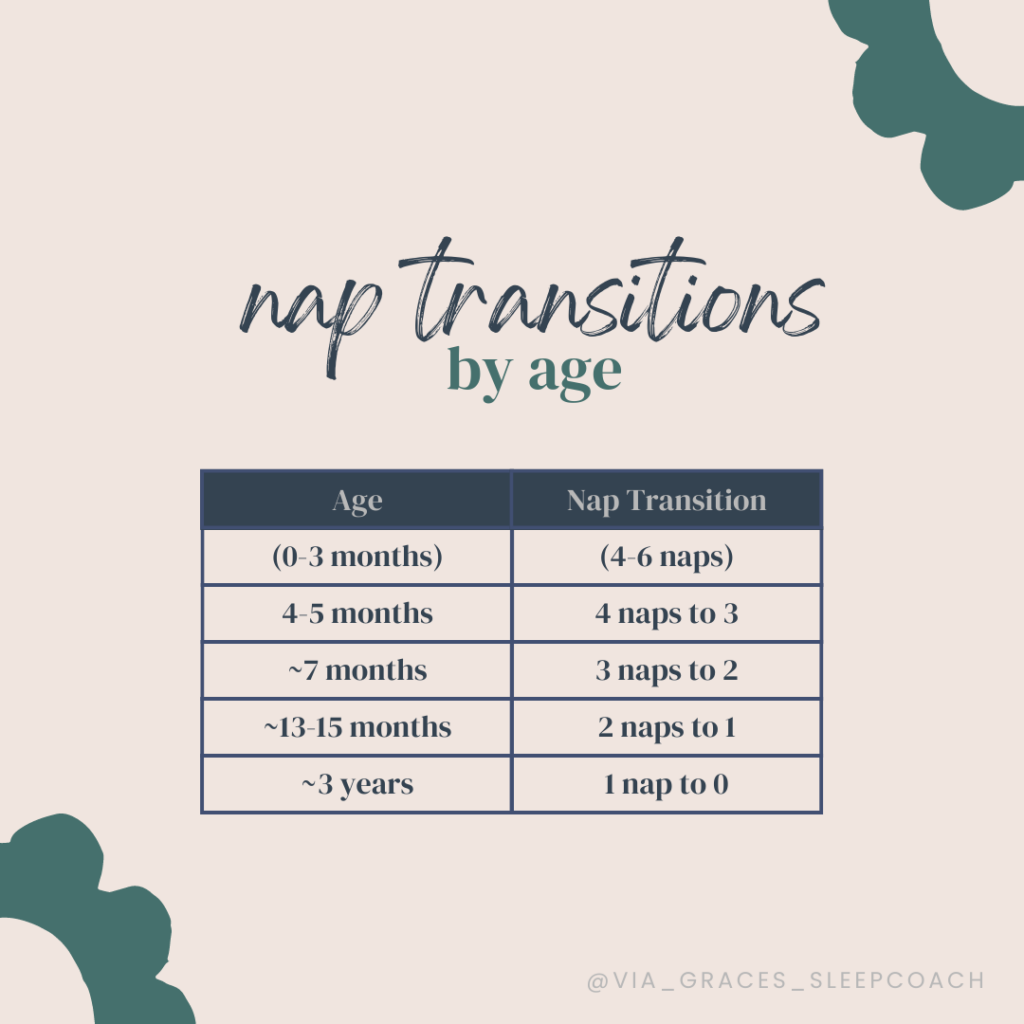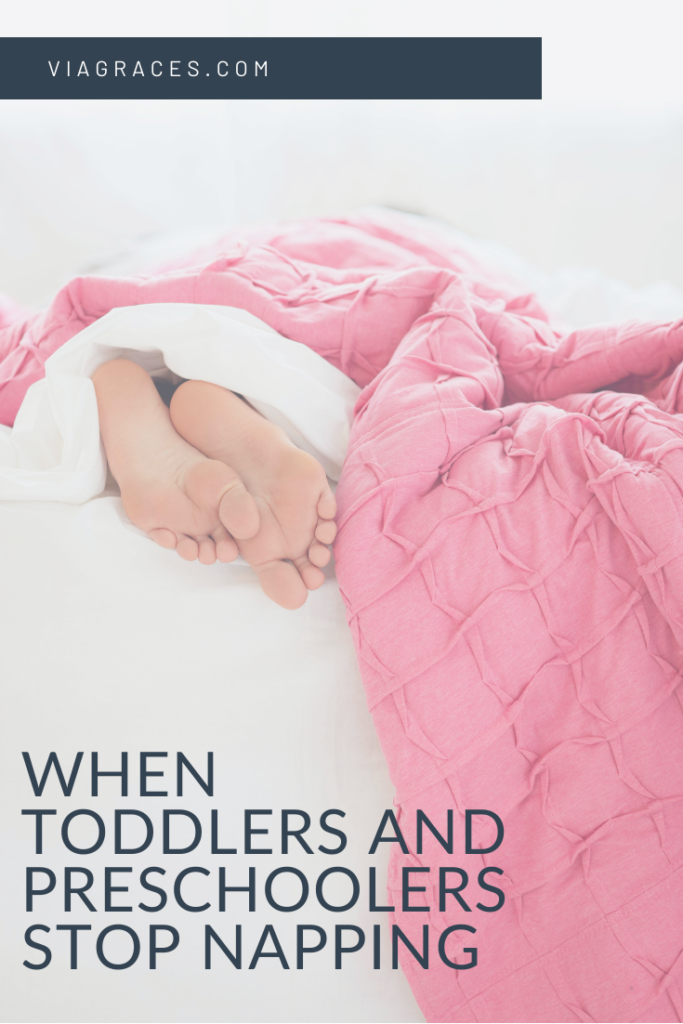Whenever I speak at mom groups or wrap up with a toddler family and mention when it might be time for their little one to stop napping, I often get confused or nervous faces and some hesitation.
It’s scary to think about your little one no longer taking a nap! One, how are you going to survive without that midday rest, and two, won’t they be so tired??
As a mama who’s done it twice now and helped so many families do the same, I promise you, you’ll make it. It’s not an easy transition, but once you’re on the other side, it’s really freeing! You don’t have to get back home for lunch and nap time, you now have the whole day! And you don’t have to lose that mid-afternoon rest time, you can replace that old nap time with a quiet time.
In this blog post, I will walk you through:
- When most kids are ready to drop the last nap
- Signs it’s time for your child to transition from one nap to zero naps
- How to go about dropping your child’s final nap
- Tips to help your child adjust to not taking a nap anymore
- What to do if your child still naps at daycare but not at home
And more!
What age do toddlers and preschoolers usually drop their last nap?
It’s generally time to drop your child’s final nap around the age of 3, although for some it comes as early as 2.5, and others might still be able to hang on a bit longer.
And yes, I’ve heard of the 4 and 5-year-olds who are still napping every day and still sleeping well at night, but I will tell you it’s rare for an older child to still nap and fall asleep smoothly at night and sleep all the way through!
If an older child is still napping at that age, there’s a good chance bedtime is a struggle and/or they aren’t able to get a full night of sleep. And by full night of sleep, I’m talking 10-12 hours.

This is embarrassing to admit, but I always had some notion that my children would surely keep napping until at least the age of 3, because I’m a sleep consultant and I was obviously just going to get lucky.
Well, I’m humbled to admit that both of my older girls dropped their naps around the age of 2.5…jokes on me! While my girls were around the same age as each other when it was time to drop their last nap, their signs were very different.
Signs It’s Time for Your Child to Transition from One Nap to Zero
Sign One: Bedtime becomes a battle and/or gets really late
This is what happened with our oldest, Olivia. She was still taking great naps, lasting around 1.5-2 hours every day, so it certainly wasn’t a matter of not knowing how to sleep.
At bedtime, however, she protested, and she protested big. She was not that kid who could hang in her crib happily for 30 minutes before falling asleep – if she wasn’t ready for sleep, it was NOT happening. She’d scream and cry and jump and protest, and we’d check in, try to figure out what in the world was going on, reset, all the things… and then it clicked. She’s just not tired enough.
So we started by capping her nap, then we’d push bedtime back a bit later, then cap her nap again, push bedtime back a bit later, etc.. No matter how we moved things around, however, she would protest bedtime. Sometimes it would only last a few minutes, but more often than not, her protest would last 30-60 minutes and she wouldn’t fall asleep until 8:30 or 9:00 pm.
And we were not fans of that late bedtime! Our other baby was in bed by 7 and we wanted the quiet evenings we once had back!
So again, let me remind you – her nap was not the problem. It all came out at bedtime, simply because she wasn’t tired enough! This is one of the most common signs it’s time for a child to stop napping.
In order to be tired enough to fall asleep, sometimes we need to push bedtime back. And it’s very common to have to make these schedule changes as your toddler gets older!
But eventually, bedtime just gets too late – and at this age, I’m talking anything past 8:30 is too late to be able to get a full night of sleep, which is ideally still 11-12 hours, though some older kids truly only need 10.

Sign Two: Your toddler/preschooler simply stops napping!
This is what happened with my middle daughter, Avery. We would lay her down for her nap, and while she was very happy to be in her crib hanging out, singing, and playing with her lovey, sleep was not happening. Whether her nap was at 12:30, 12:45, or 1 pm, she was not falling asleep. And she’d stay content for a full 1.5-2 hours before I just called it a no-nap day!
She just wasn’t tired enough to actually fall asleep for her nap.
For some toddlers, this could look like protesting through the whole nap, just like my oldest did at bedtime! And just like I didn’t want my older daughter’s bedtime to get much later than 8:30 pm, I recommend not pushing a toddler’s nap time any later than 1 pm, and it’s for the same reason – the later their nap gets, the later they’ll sleep, and the later bedtime will get.
And we always want to protect overnight sleep, whenever possible!
Sign Three: Night wakings and/or early morning wakings creep in
Your little one may be taking a great nap during the day and falling asleep well at bedtime, but they might start having night wakings again. Or they may start waking up really early (before 6 a.m.!).
And this is all a matter of “sleep pressure.” Sleep pressure is essentially what we want building up all day, both between wake up and nap time, and nap time and bedtime, but also through the day as a whole! That sleep pressure is what helps our little ones fall asleep within 5-10 minutes, as well as stay asleep all night long.
Having night wakings out of the blue or seeing early morning wake-ups start to creep in can both be signs that a child doesn’t have enough sleep pressure built up to help them make it through the night!
You can certainly start by first capping your child’s nap. If they usually nap for two hours, for example, maybe start waking them up after 1.5 hours and see if that helps with their nights. You can also keep their nap the same and push bedtime back 15-30 minutes and see if that helps.
Eventually, however, you get to a place where your child’s nap is only 45-60 minutes (I don’t recommend capping it at any less than that), and/or their bedtime is at 8:30, and by that time there’s not really another choice besides dropping that last nap altogether.
The goal is, your child stops napping, they will have plenty of sleep pressure built up throughout the day to both fall asleep smoothly at night, and stay asleep all night long, until 6 am at the very least.
Your toddler will need to drop their final nap at some point, and you’ll know by one of those signs. However, they’re toddlers. And toddlers really know how to keep us on their toes, and toddler sleep regressions are certainly a thing, and sometimes it really is just a matter of a little schedule shift. So…
How can you tell the difference between a temporary sleep regression or schedule shift versus needing to drop the last nap altogether?
My general rule of thumb is to wait about two weeks before making a big sleep change, and dropping your toddler’s last nap is definitely one of those big sleep changes.
Toddlers are notorious for having sleep regressions, and that’s most often connected to language bursts. Their little brain is on overdrive learning this new skill, so why not wake up and practice talking at 2 am? Or what would happen if I ask for one more hug, or a drink of water, or one more book after mom and dad leave the room?
Before assuming your child is ready to stop napping and just dropping the last nap altogether, or significantly changing their nap or bedtime schedule, hang tight and remain consistent with how you approach sleep, and they may get back on track!
You can shift their schedule 15, maybe 30 minutes to see if it will help, but don’t do anything crazy.
If, after those two weeks, the majority of that time was still rough, now we’re going to make bigger schedule shifts, and then consider dropping their last nap.
Once you’ve decided it IS time to drop the final nap…
How to Drop Your Child’s Final Nap
You drop the nap! Yep, just straight-up drop it.
For my husband and me, our evenings are our time. That’s when we eat cookies and watch our favorite TV shows. Or we catch up on work, or I go for a walk. Or he hangs with his buddies. I might paint, he might play video games. After a long day of work and parenting, that time is for US!
So continuing to push Olivia’s bedtime later and later just wasn’t an option for us, so we dropped her last nap altogether, and we did so by simply not offering it anymore.
But don’t worry, that doesn’t mean your mid-afternoon break is all of a sudden gone. I recommend replacing that afternoon nap time with a quiet time! A time for your little one to play by themselves or have some screen time and reset, and a time for you to rest and reset.

So you’ve dropped the last nap, now what?
The most important part of transitioning from one nap to zero is an EARLY BEDTIME! Your little one will be tired come 4/5 p.m., and trying to push them to even a 7 p.m. bedtime is going to be rough at the beginning.
So when your child first drops that last nap, aim to have them in bed, lights out, kissing them goodnight, around 6/6:15 pm (this is based on the classic “7-7 schedule” being your end goal).
I know that sounds crazy early, and it is, but it’s necessary! Then after a week or so, if things are going well, push their bedtime 15 minutes later. Then after another week or so, 15 minutes later again, and before you know it, you’ll be at 7 pm.
If at any time you push bedtime back a bit later (i.e. from 6:30 to 6:45 pm) and your little one has a harder time falling asleep, stirs more in the night, or wakes earlier in the morning, go back to that previous time (6:30, in this example) for another week or so to help them further adjust and avoid more overtiredness.
Many parents get nervous about this early bedtime because they’re worried their child will now wake up extra early in the morning, but hear me when I say…that will very likely not be the case! Your little one will essentially “tag on” the sleep they didn’t get that afternoon and still wake up at their usual wake-up time, or potentially even sleep in a bit later.
A few extra tips for when you drop your child’s last nap:
- If your child happens to doze during quiet time or later in the afternoon after you’ve dropped their final nap (this happened to us a few times!), wake them up after 20-30 minutes so it doesn’t throw bedtime way off!
- Have another rest and snack time around 4 pm. This tends to be when kiddos who are still adjusting to no longer taking a nap tend to crash. This is a good time to allow your child to watch a little TV or have a snuggle and read time with mom or dad. Also consider having a snack with some fresh fruit in it so the natural sugars help perk them up.
- Try to avoid any longer car trips in that late afternoon/pre-dinner window so your child doesn’t fall asleep!
- Note that it usually takes around 4-6 weeks for a child to fully adjust to any nap transition, and that is absolutely the case when your child drops their last nap. You may find that your toddler or preschooler still really hits a wall come 4 p.m., or it may take a solid month+ before their bedtime actually sits at a consistent 7 p.m., and that’s all very normal!
Is there any way to hang on to that final nap as long as possible?
If you’re reading this and you’re okay with a late bedtime if that means your child can keep napping, that’s okay! The great thing about parenting is you get to make decisions that are best for your child and family.
So if you don’t mind an 8:30, 9, or maybe even 9:30 bedtime because your preschooler naps during the day, as long as they’re sleeping well overnight and seem well-rested when they wake up and throughout the day, that’s fine!
What to do if your child still naps at daycare but they no longer nap at home
If your child still naps at daycare but not at home, I know it’s confusing, maybe frustrating, but it’s not because you’re doing anything wrong. Your little one just doesn’t need that nap anymore! But at daycare, kids have what we call a “herd mentality” – everyone else is sleeping, so that’s just what they do, too!
When we work with families in this situation, that generally just means they are going to have a later bedtime during the week, maybe around 8:30 or 9, and an earlier bedtime on the weekends, closer to 7 pm. Their sleep is just going to be spread out differently!
If that late bedtime is really tough for you, or maybe your little one is struggling with the change during the week and weekend, talk to your daycare/preschool! Ask them if there’s any way your child can go to another room during nap time and play with kids who no longer nap. Or ask if you can send in some quiet activities for your child to play with, so while the other kids nap they can still rest but not sleep. Or maybe they can wake your toddler up after just 30 minutes so they can still get to bed at a reasonable time.
Remember, you are your child’s greatest advocate, AND your childcare providers want what’s best for your little one and the others in their care! So have an open conversation and find what could work for everyone.
Conclusion
While it can seem crazy to think about dropping your child’s final nap, it’s worth it for their sleep! And for yours. And I strongly recommend you replace that previous nap time with a quiet time so you can all still enjoy a mid-day rest.
I know transitioning from one nap to zero naps can be overwhelming. Your toddler might have some extra meltdowns in the evening that are tough, or having an earlier bedtime might make the evening feel crazy rushed. Or it might take some time to really get into a groove with quiet time. Please know that it’s all normal and you will get through the transition!
And if you’re having a tough time dropping your child’s last nap, or they’re really struggling overnight, know that we’re here to help! Check out what that one-on-one support could look like.
With Grace,
Lauren
